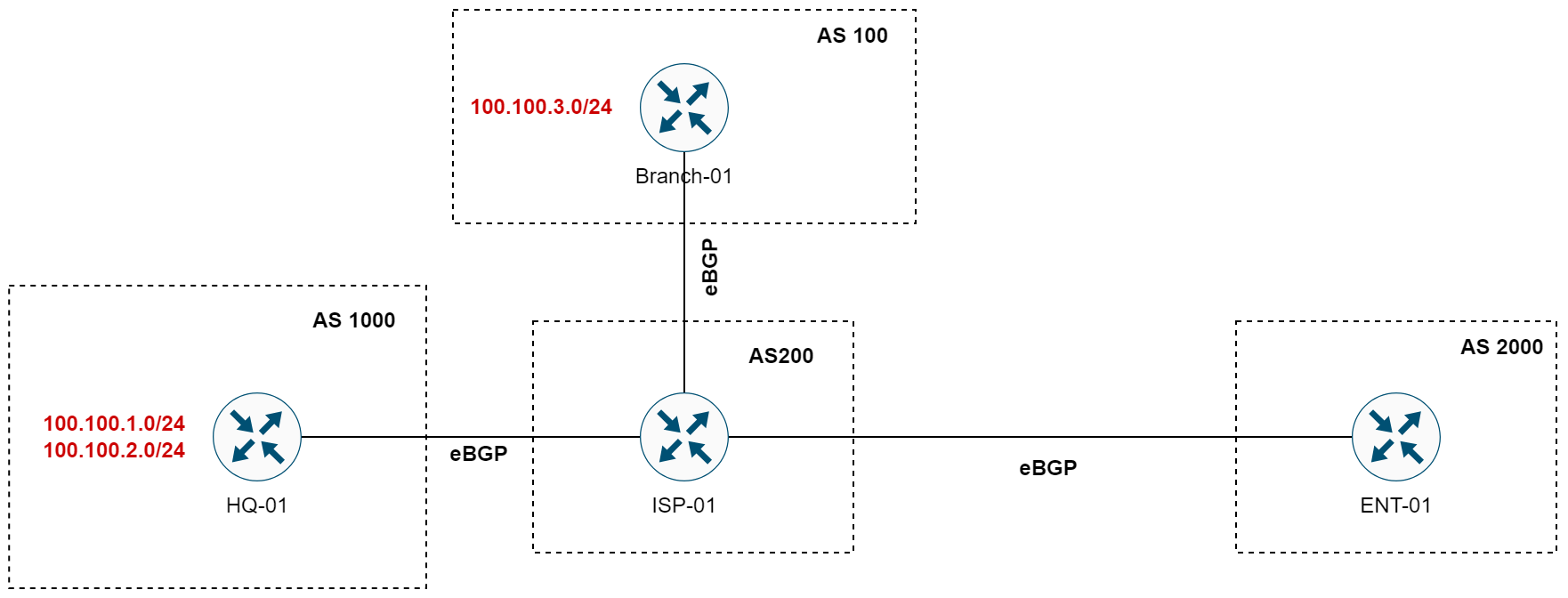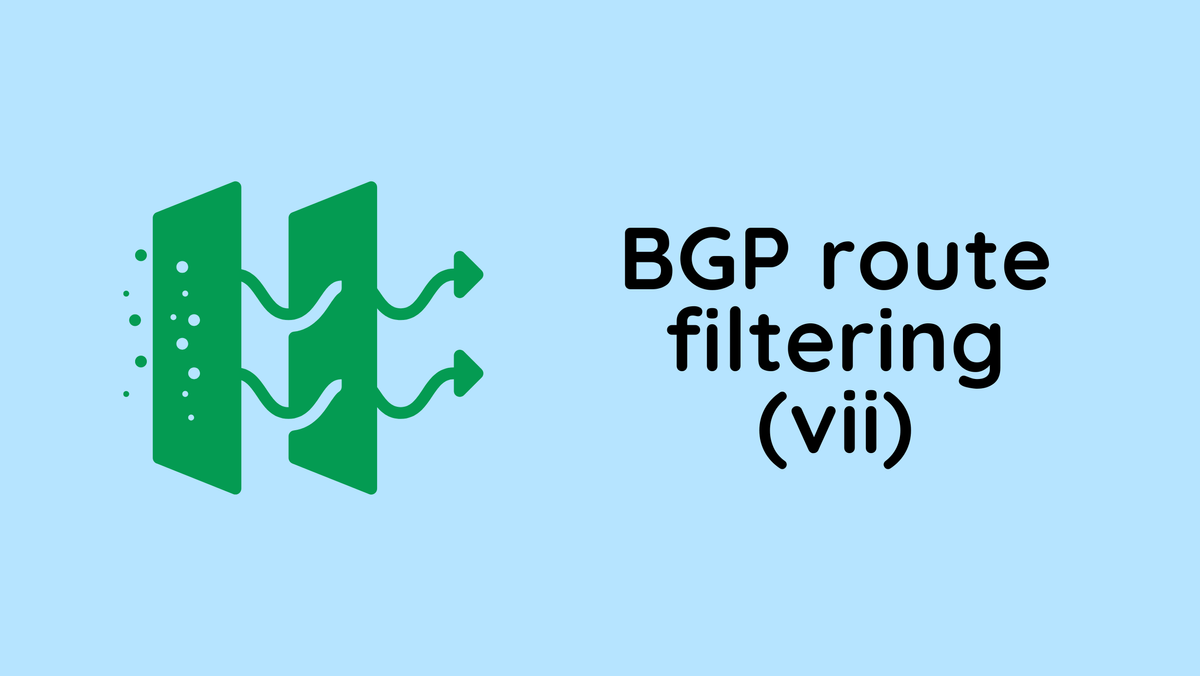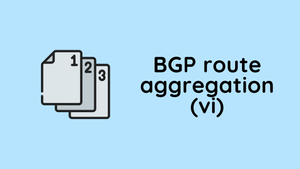In our last discussion, we looked into the concept of BGP auto-summary and how once enabled, it leads to the advertisement of classful networks without the ability to specify classless subnet masks. In this part, we will explore the mechanism of advertising custom prefix lengths through route aggregation in BGP.
Route aggregation in BGP is useful to combine multiple specific routes into a single, broader route. This technique simplifies the routing table and reduces the number of routes that need to be advertised and processed.
We will be using the following topology throughout this example where HQ-01 is in AS 1000, ENT-01 is in AS 2000, and there are two intermediary ISP routers in AS 100. These ISP routers will establish an iBGP session between each other to pass along BGP routes. HQ-01 has three connected routes which we will advertise into BGP.

#HQ-01
HQ-01#show ip interface brief | incl Loop
Loopback1 100.100.1.1 YES manual up up
Loopback2 100.100.2.1 YES manual up up
Loopback3 100.100.3.1 YES manual up up #HQ-01
router bgp 1000
bgp log-neighbor-changes
neighbor 12.12.12.2 remote-as 100Of course, we could go and add three network statements or redistribute the connected connects to advertise those three prefixes. But, our goal here is to summarize them and advertise the prefix 100.100.0.0/22 instead. If we try to add network 100.100.0.0 255.255.252.0, it won't work because BGP needs this exact prefix and mask in the routing table.
network command, there must be an identical network prefix already present in the router's routing table. This means the prefix, along with its subnet mask or prefix length, must match precisely an entry in the routing table that is reachable.Method 1 - Using 'null' routes
A null route is a routing table entry that discards traffic by directing it to a "null" interface, effectively a nowhere destination.
Let's proceed with how we can advertise a more summarized route in BGP.
- As previously discussed, if you try to add the command
network 100.100.0.0 mask 255.255.252.0within the BGP configuration on HQ-01, it won't have any effect if there isn't an exact match for this network in the routing table. - To create an entry in the routing table for this
/22network, we can configure a null route - It’s important to remember that this null route won't override any more specific connected routes because connected routes have a lower administrative distance, making them preferable. They're also considered the most specific, or the "best match," for destinations within their network.
- Once the null route for the
/22is in place, we can then add thenetwork 100.100.0.0 mask 255.255.252.0statement to the BGP configuration. BGP will see the route in the routing table and will advertise the/22to its neighbours.
This technique allows us to consolidate multiple routes into a single advertisement, reducing the size of the routing table.
#HQ-01
ip route 100.100.0.0 255.255.252.0 Null0
router bgp 1000
bgp log-neighbor-changes
network 100.100.0.0 mask 255.255.252.0
neighbor 12.12.12.2 remote-as 100HQ-01#show ip bgp
BGP table version is 28, local router ID is 100.101.1.1
Status codes: s suppressed, d damped, h history, * valid, > best, i - internal,
r RIB-failure, S Stale, m multipath, b backup-path, f RT-Filter,
x best-external, a additional-path, c RIB-compressed,
Origin codes: i - IGP, e - EGP, ? - incomplete
RPKI validation codes: V valid, I invalid, N Not found
Network Next Hop Metric LocPrf Weight Path
*> 100.100.0.0/22 0.0.0.0 0 32768 iIf I head over to the ENT-01 router on the far right, I should be able to receive this route via BGP. Let's check it out.
#ENT-01
ENT-01#show ip bgp
BGP table version is 72, local router ID is 31.31.31.1
Status codes: s suppressed, d damped, h history, * valid, > best, i - internal,
r RIB-failure, S Stale, m multipath, b backup-path, f RT-Filter,
x best-external, a additional-path, c RIB-compressed,
Origin codes: i - IGP, e - EGP, ? - incomplete
RPKI validation codes: V valid, I invalid, N Not found
Network Next Hop Metric LocPrf Weight Path
*> 100.100.0.0/22 31.31.31.2 0 100 1000 iMethod 2 - BGP aggregate-address command
There is another way to achieve the same results using the aggregate-address command but with more control and flexibility. Let's look at how it works. I'm going to remove the static route and network statement we created in the previous step. As soon as you do this, the prefix will disappear from the BGP table.
#HQ-01
HQ-01(config)#no ip route 100.100.0.0 255.255.252.0 Null0
HQ-01(config)#router bgp 1000
HQ-01(config-router)#no network 100.100.0.0 mask 255.255.252.0HQ-01#show ip bgp
HQ-01#Now, let me go and add the aggregate command and see what happens.
#HQ-01
router bgp 1000
bgp log-neighbor-changes
aggregate-address 100.100.0.0 255.255.252.0
neighbor 12.12.12.2 remote-as 100HQ-01#show ip bgp
HQ-01#Hmm, still nothing because you need either:
- A
networkstatement with one of the prefixes that fall within the aggregated prefix - One of the redistributed routes must fall within the aggregated prefix
Using network statement
So, let's go and include one of the prefixes via the network statement.
#HQ-01
router bgp 1000
bgp log-neighbor-changes
network 100.100.1.0 mask 255.255.255.0
aggregate-address 100.100.0.0 255.255.252.0
neighbor 12.12.12.2 remote-as 100#HQ-01
HQ-01#show ip bgp
BGP table version is 31, local router ID is 100.101.1.1
Status codes: s suppressed, d damped, h history, * valid, > best, i - internal,
r RIB-failure, S Stale, m multipath, b backup-path, f RT-Filter,
x best-external, a additional-path, c RIB-compressed,
Origin codes: i - IGP, e - EGP, ? - incomplete
RPKI validation codes: V valid, I invalid, N Not found
Network Next Hop Metric LocPrf Weight Path
*> 100.100.0.0/22 0.0.0.0 32768 i
*> 100.100.1.0/24 0.0.0.0 0 32768 iLooks good but hang on, why am I still seeing the individual /24 prefix? What's the point of advertising both individual /24 and the aggregated /22. Well, calm down, there is a summary-only parameter you can use to advertise just the /22 aggregated prefix.
#HQ-01
router bgp 1000
bgp log-neighbor-changes
aggregate-address 100.100.0.0 255.255.252.0 summary-only
neighbor 12.12.12.2 remote-as 100#HQ-01
HQ-01#do show ip bgp
BGP table version is 32, local router ID is 100.101.1.1
Status codes: s suppressed, d damped, h history, * valid, > best, i - internal,
r RIB-failure, S Stale, m multipath, b backup-path, f RT-Filter,
x best-external, a additional-path, c RIB-compressed,
Origin codes: i - IGP, e - EGP, ? - incomplete
RPKI validation codes: V valid, I invalid, N Not found
Network Next Hop Metric LocPrf Weight Path
*> 100.100.0.0/22 0.0.0.0 32768 i
s> 100.100.1.0/24 0.0.0.0 0 32768 i#ENT-01
ENT-01#show ip bgp
BGP table version is 76, local router ID is 31.31.31.1
Status codes: s suppressed, d damped, h history, * valid, > best, i - internal,
r RIB-failure, S Stale, m multipath, b backup-path, f RT-Filter,
x best-external, a additional-path, c RIB-compressed,
Origin codes: i - IGP, e - EGP, ? - incomplete
RPKI validation codes: V valid, I invalid, N Not found
Network Next Hop Metric LocPrf Weight Path
*> 100.100.0.0/22 31.31.31.2 0 100 1000 iLooks good now and you must have noticed s> in the HQ-01 router's output. It just says I'm suppressing the route (aka not advertising to my peers). ENT-01 router only sees the aggregated /22 prefix.
Using redistribution
In this example, let's use redistribution instead of using the network statement. I'm going to remove the network statement from the previous example and use redistribute connected instead.
#HQ-01
router bgp 1000
bgp log-neighbor-changes
aggregate-address 100.100.0.0 255.255.252.0 summary-only
redistribute connected
neighbor 12.12.12.2 remote-as 100Once configured, if I go to the router in the far right (ENT-01) and check the output, I should only be able to see the aggregated prefix.
#ENT-01
ENT-01#show ip bgp
BGP table version is 87, local router ID is 31.31.31.1
Status codes: s suppressed, d damped, h history, * valid, > best, i - internal,
r RIB-failure, S Stale, m multipath, b backup-path, f RT-Filter,
x best-external, a additional-path, c RIB-compressed,
Origin codes: i - IGP, e - EGP, ? - incomplete
RPKI validation codes: V valid, I invalid, N Not found
Network Next Hop Metric LocPrf Weight Path
*> 100.100.0.0/22 31.31.31.2 0 100 1000 iBGP aggregate-address and AS_Path
For the next example, we are going to use a slightly modified diagram. In this diagram, we have a network with four different Autonomous Systems, each connected through eBGP sessions. We have HQ-01 in AS 1000 with a couple of /24 prefixes, and Branch-01 in AS 100 with a single /24 prefix. ISP-01 sits in AS 200, functioning as an intermediary, while ENT-01 is in AS 2000, representing another separate network.

#HQ-01
router bgp 1000
bgp log-neighbor-changes
network 100.100.1.0 mask 255.255.255.0
network 100.100.2.0 mask 255.255.255.0
neighbor 12.12.12.2 remote-as 200#Branch-01
router bgp 100
bgp log-neighbor-changes
network 100.100.3.0 mask 255.255.255.0
neighbor 12.12.13.2 remote-as 200#ISP-01
router bgp 200
bgp log-neighbor-changes
neighbor 12.12.12.1 remote-as 1000
neighbor 12.12.13.1 remote-as 100
neighbor 12.12.14.1 remote-as 2000#ENT-01
router bgp 2000
bgp log-neighbor-changes
neighbor 12.12.14.2 remote-as 200ENT-01 is designed to learn about the three prefixes originating from HQ-01 and Branch-01 through its eBGP connection with ISP-01.
#ENT-01
ENT-01#show ip bgp
Network Next Hop Metric LocPrf Weight Path
*> 100.100.1.0/24 12.12.14.2 0 200 1000 i
*> 100.100.2.0/24 12.12.14.2 0 200 1000 i
*> 100.100.3.0/24 12.12.14.2 0 200 100 iBGP Atomic Aggregate Attribute
What we want to do here is make ISP-01 perform route aggregation to summarize the individual /24 prefixes into a single /22 prefix, specifically 100.100.0.0/22. Then, ISP-01 will advertise this aggregated route to ENT-01. Let's add the aggregate-address command on the ISP-01 router as shown below. Now, ENT-01 should only receive the aggregated prefix.
#ISP-01
router bgp 200
bgp log-neighbor-changes
aggregate-address 100.100.0.0 255.255.252.0 summary-only
neighbor 12.12.12.1 remote-as 1000
neighbor 12.12.13.1 remote-as 100
neighbor 12.12.14.1 remote-as 2000#ENT-01
Network Next Hop Metric LocPrf Weight Path
*> 100.100.0.0/22 12.12.14.2 0 0 200 iEverything might look okay, right? But if we take a closer look at the AS_Path information in the BGP table on ENT-01, we might spot something unusual. The AS_Paths for AS 1000 and AS 100 aren't there. It appears as if the prefixes are coming directly from ISP-01, which could be misleading. This happens because when ISP-01 aggregates the routes into a single /22 prefix, the AS_Path information of the individual /24 networks are lost.
You can use the command show ip bgp 100.100.0.0 and from the output, you can see this prefix has been aggregated by the router with RID 12.12.14.2 and the atomic_aggregate attribute is also present in the BGP update.
#ENT-01
ENT-01#show ip bgp 100.100.0.0
BGP routing table entry for 100.100.0.0/22, version 14
Paths: (1 available, best #1, table default)
Not advertised to any peer
Refresh Epoch 2
200, (aggregated by 200 12.12.14.2)
12.12.14.2 from 12.12.14.2 (12.12.14.2)
Origin IGP, metric 0, localpref 100, valid, external, atomic-aggregate, best
rx pathid: 0, tx pathid: 0x0Now, let's consider what could happen if this BGP update with the aggregated /22 prefix ends up in HQ-01 or Branch-01. Typically, BGP has loop prevention mechanisms that would prevent a router from accepting updates that include its own AS number in the AS_Path. But, since the aggregation at ISP-01 has removed the AS numbers of the individual routes if HQ-01 or Branch-01 receives this aggregate route, there is no longer an AS number to match, so they might accept the route.
BGP Route Aggregation with AS_SET
The as-set option in route aggregation within BGP is used to retain all AS numbers from the aggregated routes in the AS_Path attribute. When you use as-set, it creates a set that lists all the Autonomous Systems that the aggregated routes have passed through.
There is a way to fix or overcome this issue by adding the as-set parameter to the aggregate-adress command as shown below.
#ISP-01
router bgp 200
bgp log-neighbor-changes
aggregate-address 100.100.0.0 255.255.252.0 as-set summary-only
neighbor 12.12.12.1 remote-as 1000
neighbor 12.12.13.1 remote-as 100
neighbor 12.12.14.1 remote-as 2000Now, if we head back to ENT-01 and check the BGP table, the AS_Paths should show up.
#ENT-01
Network Next Hop Metric LocPrf Weight Path
*> 100.100.0.0/22 12.12.14.2 0 0 200 {1000,100} i({}) only counts as one hop even if there are multiple ASs listed







